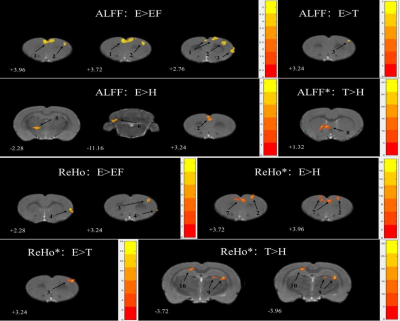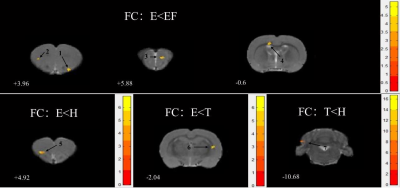1242
Effects of EGR3 transfection on behavior and resting-state fMRI in rats and evaluation of risperidone treatment in schizophrenia model1Department of Radiology, China-Japan Friendship Hospital, Beijing, China, 2Graduate School of Peking Union Medical College, Beijing, China, 3GE Healthcare, MR Research China, Beijing, China
Synopsis
Schizophrenia is a neurodevelopmental psychiatric disorder with unclear etiology and no effective treatment. In this study, we established a new schizophrenia model in rats using early growth response (EGR3) gene transfection which was injected into the hippocampus and dentate gyrus of rats. The model was examined by evaluating the behavioral impact and cerebral alterations of schizophrenia model rats using behavioral phenotyping and resting-state functional magnetic resonance imaging (rs-fMRI). In addition, the efficacy of risperidone therapy was also evaluated in treated group rats. Briefly, we found several regional alterations in the cerebrum, which were consequently partially reversed by risperidone.
Synopsis
Schizophrenia is a neurodevelopmental psychiatric disorder with unclear etiology and no effective treatment. In this study, we established a new schizophrenia model in rats using early growth response (EGR3) gene transfection (lentivirus transfection) which was injected into the hippocampus and dentate gyrus of rats. The model was examined by evaluating the behavioral impact and cerebral alterations of schizophrenia model rats using behavioral phenotyping and resting-state functional magnetic resonance imaging (rs-fMRI). In addition, the efficacy of risperidone therapy was also evaluated in treated group rats. Briefly, we found several regional alterations in the cerebrum in amplitude of low-frequency fluctuations (ALFF) and regional homogeneity (ReHo), which were consequently partially reversed by risperidone.Introduction
Schizophrenia is a complex psychiatric disorder that affects approximately 0.5-1% of global population; it is characterized by the disorder of “social brain” and disturbance of functional connectivity. Multiple genes and environmental factors have been associated with its pathogenesis. Besides clinical trials, preclinical investigation is crucial for investigating new treatment possibilities, as well as the association between different factors and disease progression. So far, several animal models for schizophrenia have been developed, which can simulate schizophrenia defects in vivo. In this study, we established a new schizophrenia model in rats using EGR3 gene transfection. The model was validated by examining the behavioral impact and cerebral alterations using behavioral phenotyping and resting-state functional magnetic resonance imaging. In addition, the efficacy of risperidone therapy was evaluated in treated group rats.Materials and Methods
Thirty-four Sprague Dawley rats were randomly divided into 4 groups: schizophrenia model group (E group), sham-operation group (FE group), healthy control group (H group) and risperidone treatment group (T group). The E group and T group were bilaterally injected with the lentivirus particle carrying EGR3 gene into hippocampus and dentate gyrus, while the FE group received an injection of green fluorescent protein instead of EGR3. After two-week recovery period, T group received an intraperitoneal injection of risperidone, while the other three groups received intraperitoneal injections of normal saline. Open field test and Morris water maze as behavioral experiment, as well as rs-fMRI were executed after 4 weeks of EGR3 gene transfection and risperidone therapy. SPSS 22.0 software was used to analyze the data. The ALFF, ReHo and FC methods were used to analyze the rs-fMRI data. Group differences in behavior test and rs-fMRI results as well as the correlations between approaches were examined.Results
EGR3 gene transfection reduced the total traveled distance in open field test and the duration in Q5 zone of Morris water maze, which suggested a reduced capability in exploring unacquainted environment and working memory (Figure 1). Moreover, risperidone treatment partially reversed the trend and improved the performance of rats on behavioral test; however, it was challenging to reach normal levels. The E group exhibited an increased ALFF in motor cortex, thalamus and cerebellum compared to FE group and H group. Risperidone decreased or reversed the EGR3 gene transfection alterations in the motor cortex, thalamus and cerebellum, while T group had significantly higher ALFF compared to H group. The E group exhibited an increased ReHo in motor cortex, somatosensory cortex and prelimbic cortex compared to FE group and H group. After risperidone treatment, T group had a higher ReHo in hippocampus compared to H group (Figure 2). There was a negative correlation between mean ReHo value and time duration at zone Q5 in Morris water maze. In addition, a negative correlation was found between behavioral parameters and ReHo values in altered brain regions (Figure 3). The E group exhibited a decreased functional connectivity of altered regions in olfactory, granular insular cortex and motor cortex compared with FE group (Figure 4).Discussion
The present study investigated the behavioral and cerebral alterations induced by EGR3 transfection and risperidone administration. To the best of our knowledge, this is the first study demonstrating profound ALFF, Reho and FC alterations in a rat model elicited by schizophrenia, suggesting that they reflect transdiagnostic neural mechanisms of schizophrenia as a developmental risk factor for psychiatric disorders.Conclusion
Schizophrenia caused by EGR3 gene transfection induced alterations in several cerebral regions including some components of limbic system and prefrontal cortex. ALFF and ReHo alterations in these brain regions could be potential markers for cognitive impairment, while risperidone can reverse and improve part of these alterations. These data lend support for future research on the pathology of schizophrenia and provide a new insight into the effects of risperidone on brain function in schizophrenia.Acknowledgements
No acknowledgement found.References
1. T.B. Song, B.B. Nie, Functional magnetic resonance imaging reveals abnormal brain connectivity in EGR3 gene transfected rat model of schizophrenia, Biochemical and Biophysical Research Communications 460 (2015) 678-683.
2. K. Schnell, Mentalizing functions provide a conceptual link of brain function and social cognition in major mental disorders, Psychopathology 47 (2014) 408-416.
3. K.J. O'Donovan, W.G. Tourtellotte, J. Millbrandt, J.M. Baraban, The EGR family of transcription-regulatory factors: progress at the interface of molecular and systems neuroscience, Trends Neurosci. 22 (1999) 167-173
Figures



